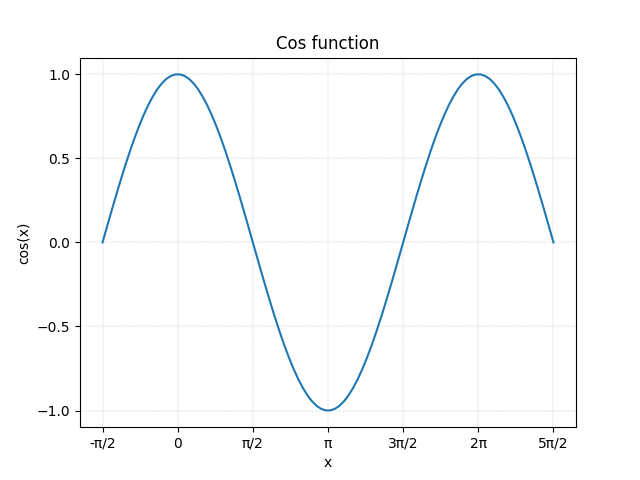Perl Math - cos() Function
The Perl Math cos() function returns trigonometric cosine of an angle (angle should be in radians). In special cases it returns the following:
- If the argument is NaN or an infinity, then the result is NaN.
In the graph below, cos(x) vs x is plotted.

Syntax
cos(x)
Parameters
x |
Specify the angle in radian. |
Return Value
Returns the trigonometric cosine of an angle.
Example:
In the example below, cos() function is used to find out the trigonometric cosine of an angle.
use Math::Trig;
print("cos(pi/6) = ".cos(pi/6)."\n");
print("cos(pi/4) = ".cos(pi/4)."\n");
print("cos(pi/3) = ".cos(pi/3)."\n");
print("cos(deg2rad(90)) = ".cos(deg2rad(90))."\n");
print("cos(deg2rad(120)) = ".cos(deg2rad(120))."\n");
print("cos(Inf) = ".cos(Inf)."\n");
print("cos(-Inf) = ".cos(-Inf)."\n");
print("cos(NaN) = ".cos(NaN)."\n");
The output of the above code will be:
cos(pi/6) = 0.866025403784439 cos(pi/4) = 0.707106781186548 cos(pi/3) = 0.5 cos(deg2rad(90)) = 6.12323399573677e-17 cos(deg2rad(120)) = -0.5 cos(Inf) = NaN cos(-Inf) = NaN cos(NaN) = NaN
This function can also be used to calculate complex cosine of a complex number z. It is a function on complex plane, and has no branch cuts. Mathematically, it can be expressed as:
Example:
In the example below, cos() function is used to find out the complex cosine of the given number.
use Math::Complex;
$z1 = 2 + 2*i;
$z2 = 2;
$z3 = 2*i;
print("cos($z1) = ".cos($z1)."\n");
print("cos($z2) = ".cos($z2)."\n");
print("cos($z3) = ".cos($z3)."\n");
The output of the above code will be:
cos(2+2i) = -1.56562583531574-3.29789483631124i cos(2) = -0.416146836547142 cos(2i) = 3.76219569108363
❮ Perl Math Functions


